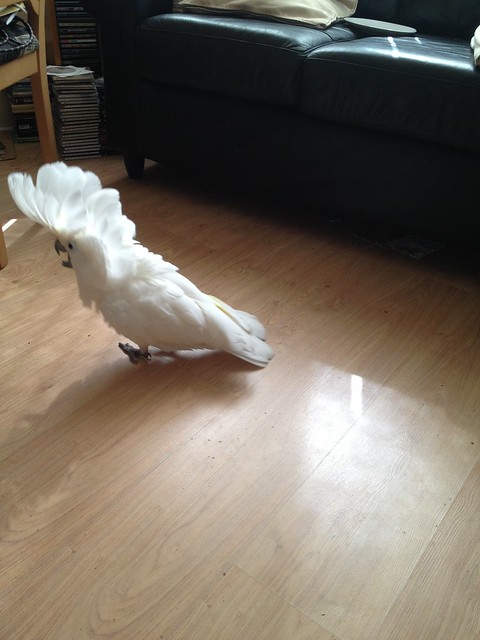If you dream of opening your own parrot rescue or sanctuary (and let’s be honest, it crosses the minds of a lot of us once we’ve seen how birds suffer in the wrong environments!), the most important step of all is to get yourself ready. Many owners find that they are not suited mentally, physically, or emotionally.
What is the difference, first of all, between a parrot rescue and a parrot sanctuary? A rescue typically rehabilitates an animal before placing it in a new “forever” home with the perfect family match. I put “forever” in quotations because a lot of rescues dislike that term. (Even with the best of intentions, most parrots can’t stay forever in one place due to their longevity. Better to avoid that label.)
A forever-home parrot sanctuary provides a permanent place for parrots to live in. These are far more difficult to maintain without accidentally tipping into hoarder territory, and the residents tend to be emotionally scarred parrots who can’t live in human homes. Sanctuary owners have to know how to say “no,” even when there is desperate need.
So how can you make sure you’re one of those special people who can handle the stress, pressure, and emotional rollercoaster of parrot rescue work? Can you build yourself up to it?
I found that, of course, the first step is to involve yourself with an organisation that you like and admire. Everyone has a different way of running their rescue. Right away, too, you’ll learn if the sight of an abused or sick animal shuts you down, or if it ignites something inside you that you can channel into helping the bird.
The first time I stepped into the Island Parrot Sanctuary, I was very upset to see or hear about the conditions some birds were recovering from – but the owners explained that the parrots can sense this. It was hard to stifle my sadness. Yet it was also important, because my emotions affected the birds I was working with.
Step two is to visit as many different rescues as possible. This helps you see how other people manage emotionally and with the astronomical cost of running one. Networking is critical. I’ve met some amazing people in the bird world, and all of them have valuable advice.
Note that you don’t have to start out purely in parrot rescue. I am a working student at a farm. This has taught me some valuable skills – including balancing feed charts and medication, maintaining detailed log books, arranging vet visits, caring for and monitoring multiple animals, and more. All of it can transfer to a sanctuary. So you could theoretically get creative and look for (farmhand) working student positions in your area.’
Step three is to get the travel bug out of your system. Whatever your age, if you wish to see the world, do it. Live your life, because soon you’re going to be tied to your work. Rescue workers don’t get to take many holidays – nor do working students, mind. I work six days a week because the animals can’t feed themselves. It’s good preparation for a sanctuary.
Step four, adopt or foster if you have the time and funds. (You know the motto: “Adopt—don’t shop!”) Go through the process of working with a special-needs bird…or birds. If you find that you can’t handle one emotionally volatile bird, or perhaps one with physical handicaps, you may not be able to handle dozens of them. Parrot sanctuaries fill up fast with those who can’t be placed in normal homes. Fostering provides a different kind of experience to adoption.
Step five: Educate. And by this, I mean blog or start a personal journal! This is actually an important step, as it lets you decompress and purge your emotions in a healthy way, get your name out there, document your journey, say what you feel is important, and make real-world connections. Social media is actually a big part of most parrot establishments. Check out your favourites and see how they reach out to their supporters.
Step six: Research. This teaches you everything you need to know about funding, loans, grants, etc. What do reputable rescues do that you like? What do disreputable rescues do? Where is a good place to open a rescue/sanctuary? How do you gain support in the community? Do you build year-round aviaries, or use a building?
Consider this also: How many birds qualify as too many? The answer is always individual. You can identify a hoarder by the condition of the animals: unclean, underfed, and neglected. I have heard many a story about a well-meaning “sanctuary” that finds itself overwhelmed.
In the end, not everyone is cut out for rescue work. There are, however, lots of roles to fill: there are owners, and then there are volunteers. Some volunteers run the social media and organise events to raise donations; some clean cages and prepare the food; some run the front office; some drive to do the actual rescue work; some do the donating! Besides all that, you don’t have to stick to the norm. I would like to open a sanctuary that takes in mostly small species, like budgies, cockatiels, conures, or parrotlets. Lots of places focus on cockatoos, and macaws. The littles tend to be forgotten when there is a psychotic cockatoo rampaging around!
I guess my point is that even if you’re not ready to open your own place, you can always help. Learning how to start a parrot rescue or sanctuary is a lot of work, but worth it when you realise that there are “20.6 million birds in 6.9 million U.S. households, as reported in the 2013-2014 American Pet Product Association National Pet Owners Survey” (http://www.avianwelfare.org/issues/overview.htm), and few parrots are easy to live with. Your average parrot sees multiple homes in the first few years of his life.
What parrot rescues and sanctuaries do you admire?








1 comment
The Pinellas Suncoast Parrot Sanctuary is in the process of being revitalized, and in need of volunteers. At present, we are a network of foster homes with a dream of establishing a permanent location. If you are interested in fostering parrots, and helping us turn our dream into reality, please email me with your phone number. kathysplace1953@yahoo.com
Leave a comment